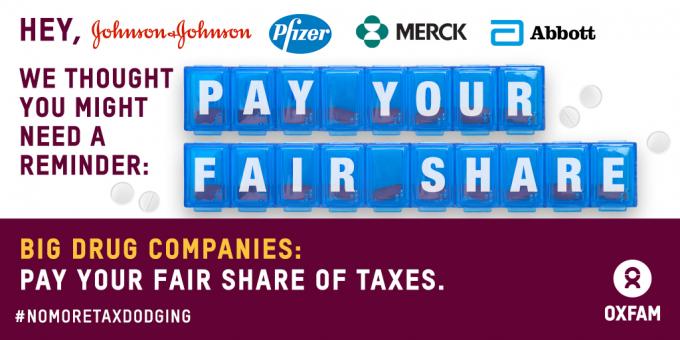It turns out drug dealers like to operate in the dark—even legitimate ones.
An earlier version of this article was posted by Oxfam International.
When we at Oxfam set out to estimate the size and scope of the tax dodging by some of the world’s biggest pharmaceutical companies for our new report, Prescription for Poverty, we had no idea it would take two years of painstaking research. Yet, because of pervasive secrecy in the tax system, we had to spend months working with local researchers to uncover even the most basic financial information about the company’s operations in countries around the world.
This secrecy is intentional—the world’s biggest companies do not want to reveal to the public where they make their money.
Even the limited data we found shows why. Oxfam scoured the corporate balance sheets of Johnson & Johnson, Pfizer, Merck and Abbott in 20 countries and uncovered alarming new evidence that these corporations appear to be using offshore tax havens to dodge billions of dollars in tax.
In both the rich and poor countries we studied, giant US drug companies report earning only small profits—6% on average. The glaring exception to that pattern is tax havens, which charge little or no corporate tax, report earning 31% profit margins. These companies appear to be inflating profits in tax havens—shortchanging every other country of desperately needed revenue that should be used to invest in vital services such as hospitals and schools.
Digging into pharma
When we began this research, we drew up a list of hundreds of US pharma subsidiaries in dozens of countries where they operate and started digging into their financial activities. We found limited data on some of the subsidiaries operating in just seven developing countries—Chile, Colombia, Ecuador, India, Pakistan, Peru, and Thailand.
We repeated the process with tax havens. Yet again huge levels of secrecy meant we were only able to extract data on subsidiaries in four tax havens—Belgium, Ireland, the Netherlands, and Singapore.
Even this limited data revealed a consistent pattern—very low profit margins in developing countries (averaging 5%) and very high profit margins in tax havens (averaging 31%).
We then questioned our findings: what if the pattern we uncovered was due to sharply discounted pricing in developing countries, rather than tax dodging?
To test that hypothesis, we embarked on a second phase of research, focusing on advanced economies that have a robust market for pharmaceuticals. We hit the same walls of secrecy, but the same overall pattern emerged—even in these rich countries, pharma companies reported only small profits margins—7%. This confirmed that pricing discounts were not driving the pattern we uncovered—the explanation, almost certainly, was tax avoidance.
But how much tax were they dodging?
Our goal was to measure how much tax these companies paid versus the actual business they do in these countries to estimate how much tax they were avoiding.
Yet again, financial and tax secrecy was a major constraint in getting an accurate assessment of drug companies’ operations. We were able to gather only the most basic financial information from pharma company subsidiaries—revenue, profits, and taxes paid. We could not get consistent information about number of employees, tangible or intangible assets, or other metrics of actual economic activity.
So we needed to try a different approach. We decided to hold the companies’ global average profit margin consistent across every country where they operated, and then calculated how much more tax they would have paid if they earned the same profit margins everywhere.
The results were revealing. The estimated tax loss in developing countries, $112 million per year, is enough to vaccinate 10 million girls against HPV, the virus that causes cervical cancer. The estimated tax loss in advanced economies was even larger, $3.7 billion per year, $2.3 billion in the US alone. This is enough to provide healthcare for nearly 1 million kids living in poverty in the US.
We do not claim that the companies are breaking the law. Not only is our estimate of economic activities very rough, but the law itself is riddled with loopholes—both companies and governments must take action to stop the race to the bottom on tax.
Are guestimates good enough?
Critics may argue the data we base our calculations on is incomplete, the methodology with which we calculate tax loss figures simplistic. And they are right.
Our tax loss estimates are rough because corporate secrecy limited our access to data. We analyzed information for only a small subset of the dozens of countries in which pharma corporations operate, and only a subset of their subsidiaries in those countries. The data we found is just the tip of the iceberg, especially for developing countries.
Our methodology to estimate tax revenue loss was limited because we did not know basic information about pharma operations in specific countries, like how many employees they had or where they located their assets.
More data would have yielded more precise estimates—but pharma companies refuse to disclose additional information.
Sunlight is the best disinfectant
We are calling on the companies to release basic financial information, like revenue, profits, taxes paid, assets, and number of employees, in every country in which they operate. Some leading companies, like Vodafone, have already voluntarily agreed to publish that information. Johnson & Johnson, Pfizer, Merck & Co (MSD), and Abbott should all do the same.
One hundred years ago, US Supreme Court Justice Louis Brandeis said, “Publicity is justly commended as a remedy for social and industrial diseases. Sunlight is said to be the best of disinfectants.”
Check out our report and let us know what you think. Better yet, join our efforts to remedy the disease of corporate tax dodging. Take action by signing our petition to Johnson & Johnson and other drug companies, calling on them to be more transparent and stop cheating women and girls out of the chance to beat poverty.

